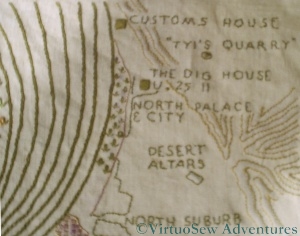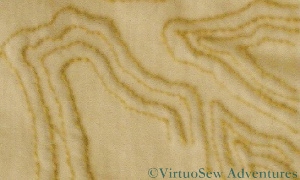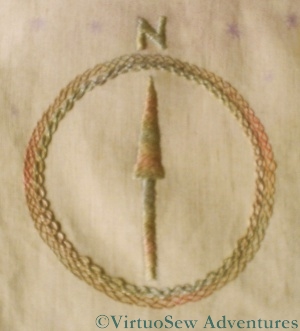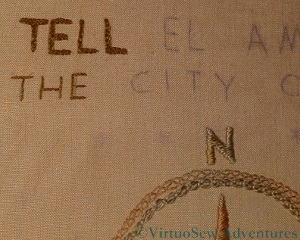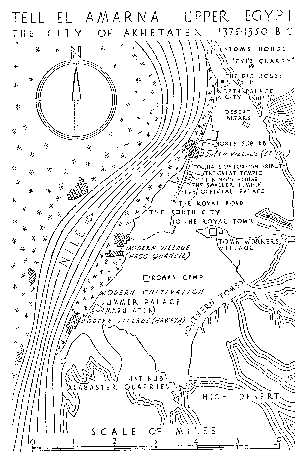Tag: The Map of Amarna
Still More Work on the Map of Amarna
This photograph shows a completed section of the Amarna Map, which demonstrates most of the design choices I have made as I went along.
The long lines to the left in the picture are worked simply in Chain stitch and represent the Nile that runs beside the site. Small tête de boeuf stitches represent the cultivation, represented by hatched stars on the original map.
The text is worked in Back Stitch. It isn’t perfectly regular, but it isn’t really intended to be, either. I knew that all my favourite line stitches would be too heavy and detailed for the scale and the intention I have, so it is deliberately chosen to be as simple as I can make it.
Remember there will be areas competing for attention here and that what I want is a general impression that the viewer can then look at more closely if they want details.
There is at least as much again to do before the Map is finished – that’s why I have tagged this post “Perseverance”!
Some Work On The Map of Amarna
Fortunately for me, I’d already had plenty of ideas for working the Map of Amarna for the first of the background panels, and in fact, as soon as I decided to include it there was one section about which I was absolutely certain – the contour lines. I’ve worked them in Reverse Herringbone Stitch. The fabric between the lines is thus slightly raised – padded by the threads behind it. I got this far on the map quite some time ago and was very pleased with myself when it turned out Just As I Hoped.
Then I moved on to another section and found myself struggling. In the drawn map, the compass rose is indicated by three lines. When I tried that, it looked clunky and rather sad. So I returned to my stitch dictionaries, and looked for line stitches. Cable Chain Stitch was an obvious choice, as it has been a favourite of mine for years, and the outer ring is worked in Closed Feather Stitch. I used two Caron Collection threads in the same colourway here – a single strand of the heavy pearl cotton type which has three strands (Watercolours, I think it is called), and the much finer one, which I think is Wildflowers. It is interesting to watch the colour changes as they appear very different and have different emphases in the different threads.
I may yet decide to run a “shadow” to one side or the other of the arrow, using a simple stitch such as stem stitch, to throw the satin stitch into stronger relief, but for the moment I am happy that the flatter outer ring creates the illusion of a raised compass rose, while still being clearly something stitched.
Dreams of Amarna – The Title on the Map
I described the first of the background panels I am planning for the Dreams of Amarna a few months ago. I will describe some of the other stitching I have done on it in another post, but I have been racking my brains since I began stitching, trying to work out how to embroider the title.
The challenge I am facing with the whole map is that I want it to be clear that it is embroidered, not screen-printed, but at the same time, I don’t want to show off every stitch I know or produce something that is so heavily stitched that it pulls the final pair of panels out of balance. So far, every time I have tried something it has been too prominent or too fiddly or Just Plain Wrong. While this is disheartening, one of the advantages of the butterfly mind is that I could stow the piece away and work on something else while waiting for inspiration.
Then suddenly, a few days ago, the Gordian Knot was loosed. I’m using ordinary stranded cotton (two strands) in the darkest shade I am allowing myself. It’s not overdyed or textured, and I am using the same thread for both rows of text.
The large text uses the Chain Stitch with Buttonhole Edging that I learnt in Month Five of the Tudor and Stuart Goldwork Masterclass. I knew it would be useful as soon as I saw it! It is slightly fiddly to work at this scale, especially using stranded thread, but importantly, it doesn’t look fiddly when it is in place.
The smaller row of text below it is in split stitch. This provides a narrow, unbroken line, again clear enough to be readable, but equally not drawing attention to itself. If I decide later that this row is a little too unassuming I can always whip the split stitches!
This now means that I know what I am doing with this panel for a while yet, and can just get stitching on it. Unfortunately the transfer that I made has worn off the centre of the fabric so a large section of map will have to be retraced and reapplied, but that can wait until I have finished the titles.
I’m greatly relieved. I’ve now got plenty to work on while I think of the next idea…
Dreams of Amarna – preparing the background
I prepared a transfer based on the map used in the book. It was easy enough to scan it, flip it, and then print it out ready to be traced over using transfer pencil. Very dull, and oh, I ached after I had finished making the transfer. It doesn’t matter where I set myself up to do this sort of thing (living room floor, dining room table…), I always end up uncomfortably placed and aching somewhere or other.
Does anyone have a solution to that?
Still, once the transfer is transferred, the fun can begin!
I’m using a sandy coloured dress-weight linen, and a variety of closely matched threads. The design needs to stand out enough to cope with being surrounded by bright images on a faience-blue background, but I don’t want it too strong. There may be a lot of unpicking and re-stitching involved here.
The panel is quite large – more than eighteen inches across – so the picture I used to create the transfer looks much more grainy at this size than it does in real life. I’m hoping for greater clarity when I start stitching it!

